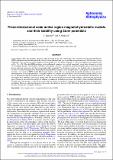Files in this item
Three-dimensional solar active region magnetohydrostatic models and their stability using Euler potentials
Item metadata
| dc.contributor.author | Terradas, Jaume | |
| dc.contributor.author | Neukirch, Thomas | |
| dc.date.accessioned | 2023-03-06T17:30:03Z | |
| dc.date.available | 2023-03-06T17:30:03Z | |
| dc.date.issued | 2023-03 | |
| dc.identifier | 281617347 | |
| dc.identifier | 001a161e-09a7-45a1-a6a4-8a381d282605 | |
| dc.identifier | 85149632097 | |
| dc.identifier.citation | Terradas , J & Neukirch , T 2023 , ' Three-dimensional solar active region magnetohydrostatic models and their stability using Euler potentials ' , Astronomy & Astrophysics , vol. 671 , A31 . https://doi.org/10.1051/0004-6361/202244687 | en |
| dc.identifier.issn | 0004-6361 | |
| dc.identifier.other | ORCID: /0000-0002-7597-4980/work/130204229 | |
| dc.identifier.uri | https://hdl.handle.net/10023/27109 | |
| dc.description | Funding: This publication is part of the R+D+i project PID2020-112791GB-I00, financed by MCIN/AEI/10.13039/501100011033. T. N. acknowledges financial support by the UK’s Science and Technology Facilities Council (STFC) via Consolidated Grants ST/S000402/1 and ST/W001195/1. | en |
| dc.description.abstract | Active regions (ARs) are typical magnetic structures found in the solar atmosphere. We calculate several magnetohydrostatic (MHS) equilibrium models that include the effect of a finite plasma-β and gravity and that are representative of these structures in three dimensions. The construction of the models is based on the use of two Euler potentials, α and β, that represent the magnetic field as B=∇α×∇β. The ideal MHS nonlinear partial differential equations are solved numerically using finite elements in a fixed 3D rectangular domain. The boundary conditions are initially chosen to correspond to a potential magnetic field (current-free) with known analytical expressions for the corresponding Euler potentials. The distinctive feature is that we incorporate the effect of shear by progressively deforming the initial potential magnetic field. This procedure is quite generic and allows us to generate a vast variety of MHS models. The thermal structure of the ARs is incorporated through the dependence of gas pressure and temperature on the Euler potentials. Using this method we achieve the characteristic hot and over-dense plasma found in ARs, but we demonstrate that the method can also be applied to study configurations with open magnetic field lines. Furthermore, we investigate basic topologies that include neutral lines. Our focus is on the force balance of the structures and we do not consider the energy balance in the constructed models. In addition, we address the difficult question of the stability of the calculated 3D models. We find that if the plasma is convectively stable, then the system is not prone in general to develop magnetic Rayleigh-Taylor instabilities. | |
| dc.format.extent | 15 | |
| dc.format.extent | 1734128 | |
| dc.language.iso | eng | |
| dc.relation.ispartof | Astronomy & Astrophysics | en |
| dc.subject | Sun: magnetic fields | en |
| dc.subject | Magnetohydrodynamics (MHD) | en |
| dc.subject | QB Astronomy | en |
| dc.subject | QC Physics | en |
| dc.subject | 3rd-DAS | en |
| dc.subject | MCC | en |
| dc.subject.lcc | QB | en |
| dc.subject.lcc | QC | en |
| dc.title | Three-dimensional solar active region magnetohydrostatic models and their stability using Euler potentials | en |
| dc.type | Journal article | en |
| dc.contributor.sponsor | Science & Technology Facilities Council | en |
| dc.contributor.sponsor | Science & Technology Facilities Council | en |
| dc.contributor.institution | University of St Andrews. Applied Mathematics | en |
| dc.identifier.doi | https://doi.org/10.1051/0004-6361/202244687 | |
| dc.description.status | Peer reviewed | en |
| dc.identifier.url | https://arxiv.org/abs/2212.04735 | en |
| dc.identifier.grantnumber | ST/W001195/1 | en |
| dc.identifier.grantnumber | ST/S000402/1 | en |
This item appears in the following Collection(s)
Items in the St Andrews Research Repository are protected by copyright, with all rights reserved, unless otherwise indicated.

